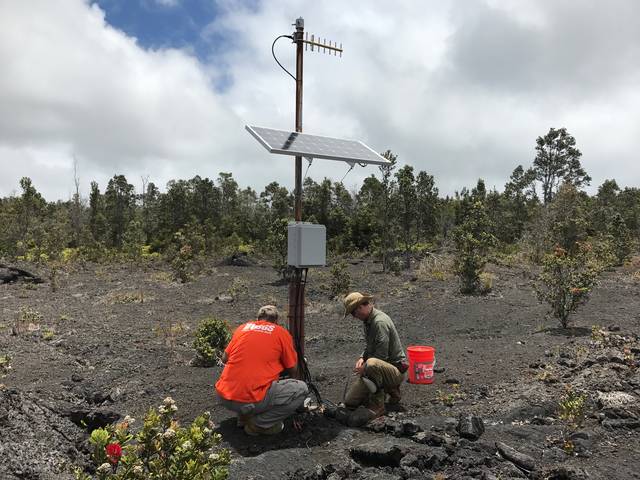VOLCANOS NATIONAL PARK — Most people likely know that the USGS Hawaiian Volcano Observatory (HVO) uses seismometers and Global Positioning System (GPS) receivers for monitoring volcanoes. However, fewer people may be aware of the full extent of our volcano-monitoring toolkit.
Today’s Volcano Watch addresses this instrumentation, but still only scratches the surface of the great variety of equipment that HVO scientists use to monitor Hawaiian volcanoes.
HVO has an extensive network of remote monitoring stations which continuously telemeter data back to the observatory. We also have instruments that are used to collect data during periodic campaign surveys, in which HVO scientists collect data on site during a field visit.
Digital communications allow HVO field engineers to integrate all of HVO’s monitoring capabilities into a single telemetry system that we refer to as the “volcano monitoring network.”
At a volcano observatory, instrumentation is tasked by scientific disciplines including geology, geophysics, and geochemistry. HVO scientists constantly reach beyond their particular areas of expertise to compare findings from as many monitoring methods as they can.
In general, HVO monitors volcanic activity through observation (seeing, listening, feeling, and smelling) and by making measurements. Roughly translated, HVO geologists “see” with tools like web cameras; geophysicists “listen and feel” with seismometers, and measure with tiltmeters and GPS; and geochemists “smell” (observe and measure) with ultraviolet spectrometers.
Many monitoring instruments require additional devices to monitor non-volcanic phenomena to interpret the data. For example, rainfall can cause ground tilt changes and can scrub out some volcanic gas. These additional support instruments, such as a rain gauge, help HVO scientists distinguish real signals from non-volcanic processes.
Let’s take a closer look at the instruments in HVO’s volcano monitoring network.
HVO geologists use various types of cameras for observation, including fixed-view webcams, thermal cameras, and time-lapse cameras. Geologists cleverly “stack,” or combine, images from these camera systems to create a single composite image that visually traces the hotspots of active lava flows over time. Thermal cameras have replaced radiometers for monitoring lava lake activity; both instruments detect changes in infrared radiation, or temperature, as the lava lake surface rises and falls, but thermal cams also provide images that are used for additional study of lava lake motion and behavior.
Geophysicists include geodesists, scientists who study ground deformation (inflation and deflation of the volcano) and seismologists, who study earthquakes.
Instruments used by HVO geodesists include GPS, tiltmeters, and gravimeters. By GPS, we mean multi-frequency receivers with a GPS antenna permanently affixed to a monument anchored to the earth. With GPS, HVO geodesists can measure surface movement in both horizontal and vertical directions. Tiltmeters measure changes in ground tilt, which allow us to recognize, among other things, accumulation of magma into various structures of the volcano. Gravimeters measure small changes in gravitational pull, useful for observing subsurface intrusions of magma and mapping accumulations of minerals associated with magma storage systems.
HVO seismologists require a variety of instruments to detect and record earthquakes, including seismometers with different geophones, frequency response (short period and broadband), accelerometers, and infrasound sensors. Each type of seismic instrument has specific characteristics that seismologists have determined to be necessary for specific monitoring goals. Every seismic station also has a GPS receiver used for signal timing and location accuracy.
HVO geochemists use ultraviolet (UV) spectrometers for both campaign surveys, as well as permanent installations. UV spectrometers allow geochemists to derive gas concentrations by measuring how much sunlight passes through a volcanic plume. Volcanic emission monitoring instruments also include both low- and high-resolution sulfur dioxide sensors, thermocouples to measure fumarole temperatures, and particle sensors to assess airborne particle concentrations. Gas monitoring instrumentation also requires support instruments, such as anemometers (measures wind speed) and rain gauges. Some gas monitoring sites also require canisters of known gas concentrations that are used to calibrate measurements.
Scientists at HVO use these tools and many more to further our monitoring capabilities and our understanding of volcanoes. HVO field engineers are constantly challenged with the task of integrating new instrumentation into the volcano monitoring network. Although it’s a daunting task, this work is both intriguing and comforting; after all, Hawaiian Volcano Observatory staff live on these active volcanoes, too.
Volcano Activity Updates
This past week, Kilauea Volcano’s summit lava lake level fluctuated between about 118 to 138 feet below the vent rim. On the East Rift Zone, the 61g lava flow remained active downslope of Puu Oo, with scattered breakouts on Pulama pali. No lava is entering the ocean. The 61g flows do not pose an immediate threat to nearby communities.
Mauna Loa Volcano is not erupting. A few small-magnitude earthquakes occurred beneath the volcano, primarily on its west flank, at depths shallower than 8 miles. GPS and InSAR measurements continue to show slow deformation related to inflation of a magma reservoir beneath the summit and upper Southwest Rift Zone. Rates of inflation in the past few months have decreased compared to rates of the past year. It is uncertain if these lower rates will persist or pick up again in the near future. No significant changes in volcanic gas emissions were measured.
No earthquakes were reported felt in Hawaii this past week.
Please visit HVO’s website for past Volcano Watch articles, Kilauea daily eruption updates, Mauna Loa weekly updates, volcano photos, maps, recent earthquakes info, and more. Call for summary updates at 967-8862 (Kilauea) or 967-8866 (Mauna Loa). Email questions to askHVO@usgs.gov.
Volcano Watch (https://volcanoes.usgs.gov/hvo/hvo_volcano_watch.html) is a weekly article and activity update written by U.S. Geological Survey Hawaiian Volcano Observatory scientists and affiliates.

